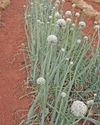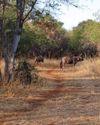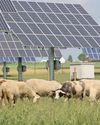
In 2010, when Barry Meijer bought Meijer's Rust near De Rust in the Klein Karoo, the soil was bare and depleted. Nevertheless, he managed to produce a small crop of barley and oats each year on the 14ha he had under irrigation, while he restricted his cattle to the hills and mountains, where they primarily lived off spekboom.
About seven years ago, Meijer realised he needed an 'intervention' to improve the water-holding capacity of the soil: "The soil was nothing more than dust. It was dead and compacted, resulting in poor water penetration and a lot of run-off."
This was a huge problem. The farm receives about 350mm of rain during a normal year but recorded less than 200mm per year for more than seven years, and below 100mm in one of those years, up until last year. The drought seemed to be broken last winter, but water reserves came under pressure again this summer, when thunderstorms were not accompanied by their usual rains.
Meijer ascribes the lower rainfall to climate change: "Climate change is real. It is resulting in lower rainfall in the Klein Karoo and shifts in the time we receive our rains. It is predicted to result in more extreme weather in future, such as droughts, heatwaves and floods, making it increasingly important to build a soil structure that can withstand these stressors."
REGENERATIVE FARMING
Meijer's search for a way to improve the water-holding capacity of his soil led him to a YouTube conversation between two regenerative agriculture pioneers, Buz Kloot and Ray Archuleta. In the video, they discussed the importance of having 'living roots' in the soil and how this could improve soil structure and, in effect, the water-holding capacity of the soil.
Denne historien er fra June 28, 2024-utgaven av Farmer's Weekly.
Start din 7-dagers gratis prøveperiode på Magzter GOLD for å få tilgang til tusenvis av utvalgte premiumhistorier og 9000+ magasiner og aviser.
Allerede abonnent ? Logg på
Denne historien er fra June 28, 2024-utgaven av Farmer's Weekly.
Start din 7-dagers gratis prøveperiode på Magzter GOLD for å få tilgang til tusenvis av utvalgte premiumhistorier og 9000+ magasiner og aviser.
Allerede abonnent? Logg på

When short-term rentals make sense
Bianca Smit, national operations manager at CFAO Equipment SA, outlines factors to consider when choosing a rental equipment partner.

The timing of onion sowing is critical
Each onion variety has a different resistance to bolting, thus growers need experience and knowledge to guide them,

Understanding cannabis and hemp regulations in South Africa
South Africa's cannabis and hemp regulations remain a topic of debate and uncertainty, particularly when it comes to commercial use and small-scale production. Cannabis experts Shaad Vayej and Trenton Birch spoke to Octavia Avesca Spandiel about the challenges that small-scale cannabis and hemp farmers face.

European seed's influence on the US cannabis market
The expansion of European cannabis seed onto the US market is not just about economic growth; it’s also about enriching the landscape of US cannabis with diversity, innovation and education,

'It's important to get the right tool for the job'
The adoption of technology is crucial to sustaining efficiency gains and beating the cost-price squeeze in the agriculture sector.

A brilliant bushveld break between Bela-Bela and Modimolle
The distinctive touch, diligence, and 24/7 customer care are just a few of the reasons you should visit four-star Tourism Council-graded Pumula Game Farm,

John Deere: elevating performance and efficiency in modern farming
In the fast-paced world of farming, the right tools make all the difference.

The naval disaster Winston Churchill tried to hide
Three British warships were sunk by German naval gunfire on a dark day early in World War II, but the heroes who fought back received only muted recognition, possibly to avoid bad publicity,

Breaking down the principles of regenerative farming
Jean Hugo, a post-graduate student at the Tshwane University of Technology, and Leon Hugo, author on environmental matters and former professor of geography at the University of Pretoria, write about the importance of regenerative agriculture for small-scale farmers, and the challenges related to making the shift.

Ectoparasite control: more tips for livestock farmers
To reduce the mayhem that uncontrolled ectoparasites can create for communal farmers, it’s best to adopt a holistic approach in conjunction with veterinary remedies,